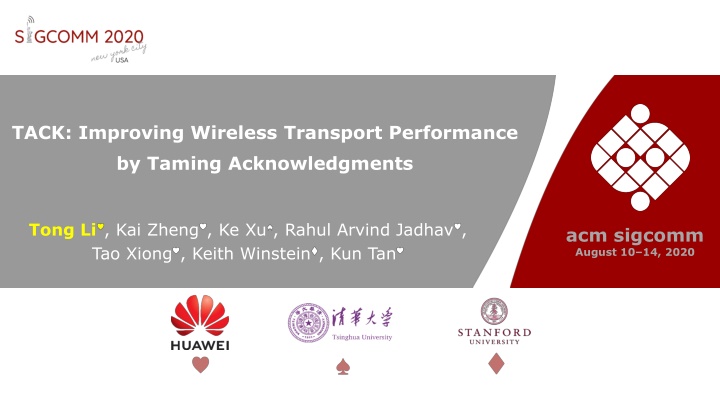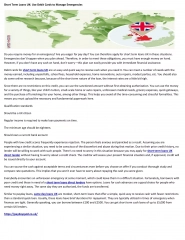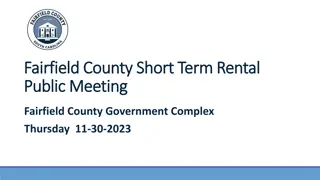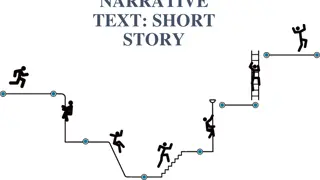
Improving Wireless Transport Performance Through ACK Optimization
Explore how adjusting the frequency of acknowledgments (ACKs) can enhance throughput in wireless networks, including challenges, solutions, and impact on TCP performance. Dive into research insights and experimental results in this domain.
Download Presentation

Please find below an Image/Link to download the presentation.
The content on the website is provided AS IS for your information and personal use only. It may not be sold, licensed, or shared on other websites without obtaining consent from the author. If you encounter any issues during the download, it is possible that the publisher has removed the file from their server.
You are allowed to download the files provided on this website for personal or commercial use, subject to the condition that they are used lawfully. All files are the property of their respective owners.
The content on the website is provided AS IS for your information and personal use only. It may not be sold, licensed, or shared on other websites without obtaining consent from the author.
E N D
Presentation Transcript
TACK: Improving Wireless Transport Performance by Taming Acknowledgments Tong Li , Kai Zheng , Ke Xu , Rahul Arvind Jadhav , Tao Xiong , Keith Winstein , Kun Tan acm sigcomm August 10 14, 2020
Wireless local area network (WLAN) High Speed Rails (HSRs) demands high throughput 100 Mbps 200 Mbps 500 Mbps 30 92 Mbps Mbps Average Peek UHD VR 2018 2023 Ultra-high-definition (UHD) wireless projection UHD Cameras (Security) Self Driving Vehicle Diagnostics 8K Wall TV Application Requirements UHD VR Cloud Gaming UHD IP Video HD VR UHD VR Streaming Streaming Average (Mbps) 16 16 17 20 30 51 100 167 500 Source: Cisco Annual Internet Report, 2018 2023 VR interactive gaming 8K Videos from Youtube Asteroid Discovery The Las Vegas Strip TOKYO HDR Time Lapse Angel Falls, Venezuela Tigers Go For A Swim Henosis(8K Short Film) NORWAY Average (Mbps) 81.0 81.1 129.1 62.8 57.7 72.0 40.6 Peek (Mbps) 206.9 196.9 134.2 83.2 81.3 72.1 71.1 AR interactive gaming Source: Huawei iLab, 2017 2
TCP ACKs cause internal interference ACK: ACKnowdedgement External Interference Internal Interference TCP forward path Data packets TCP backward path ACK packets External Interference Between wireless devices on the same channel Internal Interference Between data packets and ACKs in the same connection 3
ACKs cause similar medium access overhead Inter-frame space (IFS) Contention window (random back off) Last frame Next frame Time Extra overhead for sending each packet independent with packet size Medium acquisition overhead in WLAN based on the IEEE 802.11 medium access control (MAC) protocol 4
Reducing ACK frequency improves throughput ACK frequency increases (a) ACK throughput (b) Data throughput Experiments for contention between data packets and ACKs over 802.11n wireless links *Data is collected by a UDP-based simulation tool Ackemu (https://github.com/fillthepipe/ackemu) 5
But, simply reducing ACK frequency hurts TCP performance A TCP receiver which does not generate an ACK for every second full-sized segment exhibits a "Stretch ACK Violation". Reducing ACK frequency has both positive effect and negative effect --- 1999, RFC 2525, Vern Paxson et.al throughput (Mbps) Positive Effect TCP s transport control depends on frequent ACKs Negative Effect Goodput of legacy TCP Ideal goodput with reduced ACK frequency Actual goodput with reduced ACK frequency but without advancements 6
So, lets tame the acknowledgements Goal: Seek the optimal ACK frequency with corresponding improvements in transport mechanism to avoid the negative effect 7
Takeaways TCP s delayed ACK is far from being optimal Our way of avoiding negative effect is a TACK-based acknowledgement mechanism An approximately minimized ACK frequency works better than expected 8
Takeaways TCP s delayed ACK is far from being optimal Our way of avoiding negative effect is a TACK-based acknowledgement mechanism An approximately minimized ACK frequency works better than expected 9
Delayed ACK is not bounded or not minimized under bandwidth change RFC 1122 & RFC 5681 ACK frequency Modeling: ? ???,1 ?? ?? 1 ????_???????= ??? = ??? 2 ???, ? 500 ?? ?? ? ??? ?? ?? <? ??? ? ? (Byte-counting ACK) (Periodic ACK) bw: data throughput MSS: maximum segment size L: number of full-sized packets counted before sending an ACK ? ?: time interval between two ACKs f: ACK frequency with unit of Hz, i.e., number of ACKs per second 10
Tame ACK (TACK) ? ???,1 ?? ????? ? ???, ? ?????= ??? = ??? ? ?????? ?? ??? < ? ? ??? ?? ??? ? ? ??? (Byte-counting ACK) (Periodic ACK) ?????: the maximum bandwidth estimate ??????: the minimum RTT estimate ?: the number of ACKs per ?????? ???: the bandwidth and delay product (????? ??????) 11
Takeaways TCP s delayed ACK is far from being optimal Our way of avoiding negative effect is a TACK-based acknowledgement mechanism An approximately minimized ACK frequency works better than expected 12
Takeaways TCP s delayed ACK is far from being optimal Our way of avoiding negative effect is a TACK-based acknowledgement mechanism An approximately minimized ACK frequency works better than expected 13
How to avoid TACKs negative effect? Issues in loss recovery Reducing ACK frequency enlarges feedback delay upon loss events. ACK loss or retransmission loss doubles the delay Issues in round-trip timing Generating only one RTT sample among multiple packets is likely to result in biases Issues in send rate control CC: The fewer ACKs sent, the larger the bursts of packets released FC: Delay acknowledging packet receipts and reporting rwnd, resulting in feedback lags and bandwidth under-utilization 14
Features of TACK-based acknowledgement mechanism More types of ACKs Apart from the ACK type of TACK, also introduce the ACK type of IACK ( Instant ACK IACK and TACK are complementary More necessary information carried in ACKs Carry more contiguous range of lost packets when ACK loss rate has reached a critical level Sync ACK delay, timestamp, loss rate, delivery rate, etc. between endpoints Less number of ACKs, but are exactly what are required by transport IACK is instant event-driven , whose frequency is usually low and negligible The design rationale: an analogy 15
TACK-based protocol design Data Sender Data Advancements in loss recovery Packet number, TACK+IACK Receiver Receive Buffer Send Buffer 5 6 7 8 1 2 3 4 Advancements in round-trip timing One-way delay as auxiliary Monitor Receive Loss Recovery Feedback Handling TACK-based ACK Mechanism Round-trip Timing Advancements in send rate control Congestion control: Pacing Flow control: IACK TACK/IACK Send Rate Control Send Data Packet For more details, please refer to the paper. Goal: Decrease TCP s dependence on frequent ACKs 16
Takeaways TCP s delayed ACK is far from being optimal Our way of avoiding negative effect is a TACK-based acknowledgement mechanism An approximately minimized ACK frequency works better than expected 17
Takeaways TCP s delayed ACK is far from being optimal Our way of avoiding negative effect is a TACK-based acknowledgement mechanism An approximately minimized ACK frequency works better than expected 18
Evaluation TCP-TACK implementation TCP-TACK: A TCP implementation that applies TACK and deploys the advancements as specified above Co-design the receiver-based BBR as a TACK-based congestion controller ? = 2, ?=4 Experiment setup TCP BBR represents TCP using BBR as congestion controller and RACK as loss detection algorithm New BPF socket option, BPF_SOCK_OPS_ACK_THRESH_INIT, to allow changing the TCP ACK frequency (https://github.com/fillthepipe/TcpAckThinning) Wireless tests are in a public room with over 10 additional APs and over 100 wireless users at peak time. Ping test shows that the RTT varies between 4 to 200 ms and slight burst losses exist 19
TACK-based protocol in WLAN Percentage of goodput improvement of TCP-TACK over TCP-BBR in WLAN 20
TACK-based protocol in WAN Violin-plots of performance ranking (Results are from data traces during 200 days: https://pantheon.stanford.edu/summary) 21
Takeaways TCP s delayed ACK is far from being optimal TACK adopts a min instead of a max to assure the minimized ACK frequency in the context of network dynamics Our way of avoiding negative effect is a TACK-based acknowledgement mechanism With more types of ACKs and more necessary information carried in ACKs, less number of ACKs are required An approximately minimized ACK frequency works better than expected TACK-based protocol provides a good replacement of legacy TCP in WLAN, and also works well in WAN scenarios. TACK and its corresponding improvements in transport mechanism can also be adopted into other stacks (e.g., QUIC) to compensate for scenarios where the acknowledgement overhead is non-negligible tcpm wg: https://tools.ietf.org/html/draft-li-tcpm-advancing-ack-for-wireless-00 quic wg: https://tools.ietf.org/html/draft-li-quic-optimizing-ack-in-wlan-00 22
Thank You! Email: li.tong@huawei.com Q & A






















